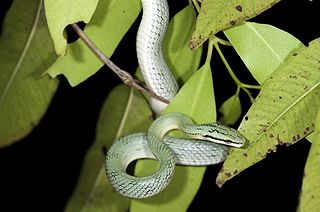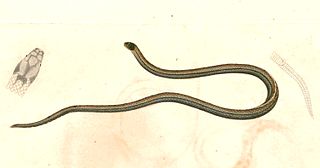
The Caucasian agama is a species of agamid lizard found in the Caucasus, E/S Georgia, Armenia, Azerbaijan, Turkmenistan, Tajikistan, Dagestan (Russia), E Turkey, Iraq, N Iran, Afghanistan, NW Pakistan, and parts of Kashmir.

Cerberus rynchops, also known as the New Guinea bockadam, South Asian bockadam, bockadam snake, or dog-faced water snake, is a mildly venomous species of a snake in the family Homalopsidae. It is native to coastal waters of South and Southeast Asia. The species was re-delimited in 2012, allocating populations east and south of the west coast of Thailand to other species.

Dendrelaphis tristis is a species of tree-snake found in South Asia.

Gonyosoma frenatum is a species of colubrid snake found in Northeast India, southern China, Taiwan, and Vietnam.

The common kukri snake or banded kukri, Oligodon arnensis, is a species of nonvenomous colubrid found in Sri Lanka, India, Bangladesh, Pakistan, Bhutan and Nepal.

Oligodon dorsalis, the Bengalese kukri snake or Gray's kukri snake, is a species of snake.

Streaked Kukri Snake(Oligodon taeniolatus) is a species of nonvenomous snake found in Asia. Also known as the Variegated Kukri or the Russell's Kukri.
Oligodon catenata, the Assam kukri snake, is a species of snake.

The Southern Ghats slender gecko is a species of gecko with a restricted distribution in the hills of southern India.

The red-crowned roofed turtle or Bengal roof turtle is a species of freshwater turtle endemic to South Asia. It was the type species of its former genus Kachuga. Females can grow to a shell length of 56 cm (22 in) and weigh 25 kilograms (55 lb), but males are considerably smaller. The turtles like to bask in the sun on land. In the breeding season, the heads and necks of male turtles exhibit bright red, yellow and blue coloration. The females excavate nests in which they lay clutches of up to thirty eggs.

Eumeces schneiderii, commonly known as Schneider's skink or the Berber skink, is a species of lizard in the family Scincidae. The species is endemic to Central Asia, Western Asia, and North Africa. There are five recognized subspecies.
The big-eared lipinia is a species of skink in the family Scincidae. It is endemic to the Andaman and Nicobar Islands of India.
The white-spotted supple skink is a species of diurnal, terrestrial, insectivorous skink found in parts of tropical Asia. This species was first described by John Edward Gray based on type specimen collected by T. C. Jerdon from Madras, in the Coromandel Coast of South India.
Eutropis beddomei, commonly known as Beddome's skink or Beddome's mabuya, is a species of skink endemic to India and Sri Lanka.
The striped grass mabuya, also called striped grass skink, is a species of skink found in South Asia.
Blanford's mabuya ( is a species of skink found in peninsular India.

Eutropis multifasciata, commonly known as the East Indian brown mabuya, many-lined sun skink, many-striped skink, common sun skink or (ambiguously) as golden skink, is a species of skink.

Eutropis rugifera, variously known as Nicobar Island skink or rough-scaled sun skink, is a species of skink from southeastern Asia.
Ophiomorus tridactylus, commonly known as the three-toed snake skink, is a species of skink endemic to sandy desert areas of South Asia. It is also called the Indian sand-swimmer for its habit of moving just under the sand.
Hydrophis viperinus, the viperine sea snake, is a species of Elapidae and Thalassophina viperina is its synonym. It is thought to be naturally rare but widespread. It is venomous.













